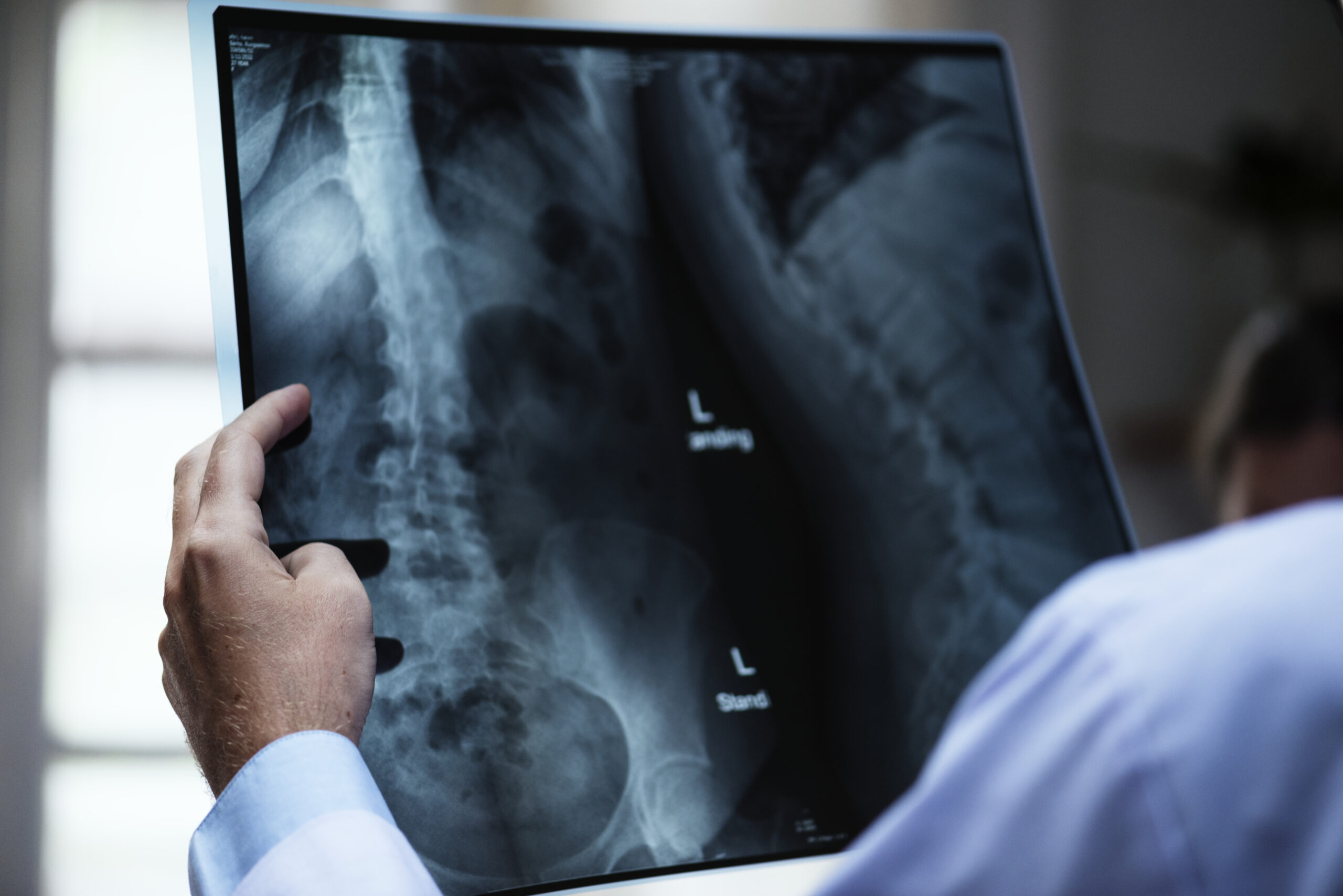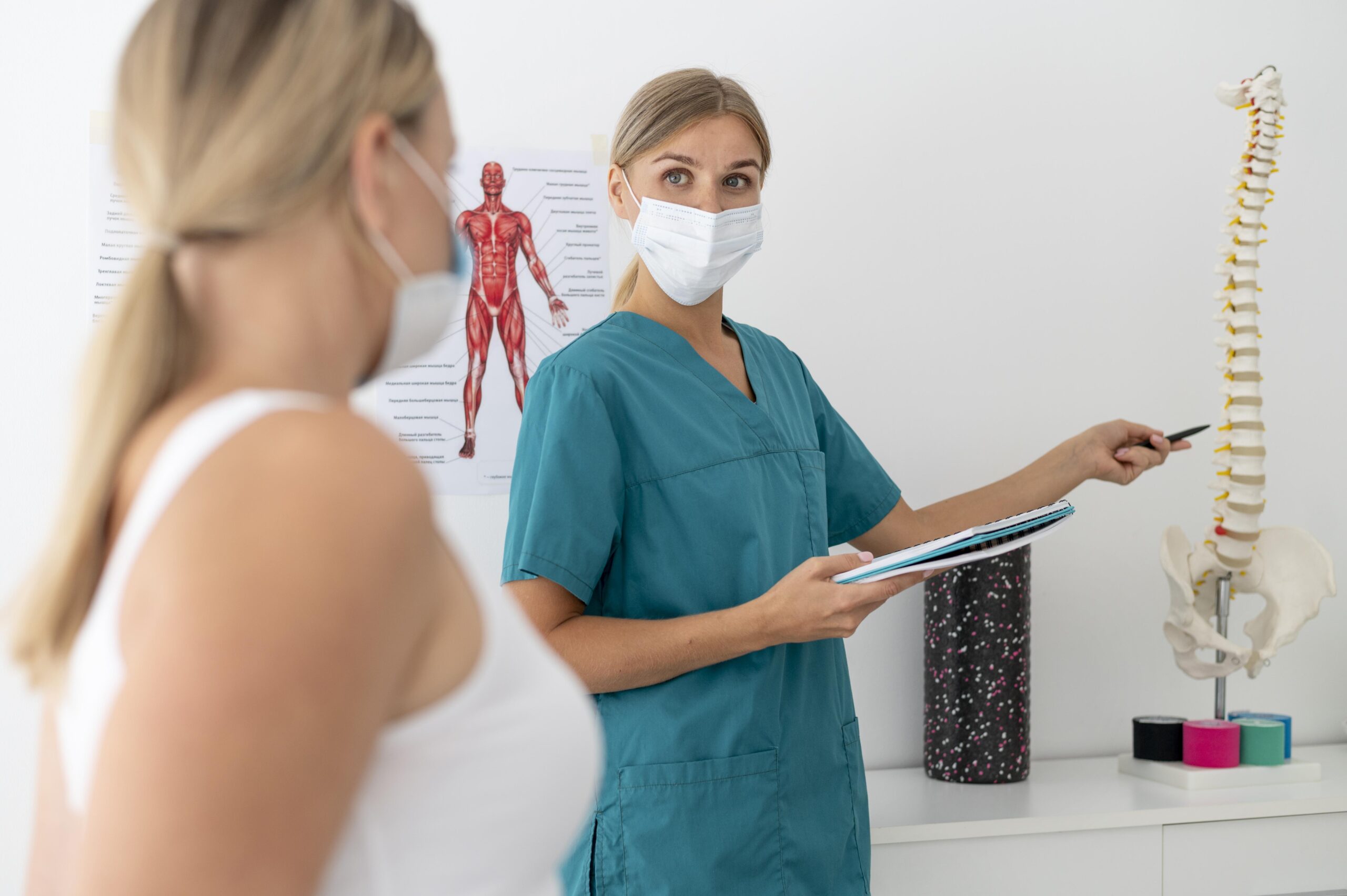Sciatica is pain radiating from the lumbar-sacral spine and buttock through the back of the thigh and lower leg to the foot. The pain occurs in the area innervated by the sciatic nerve and may sometimes be accompanied by neurological symptoms, such as sensory disturbances or muscle weakness. Symptoms result from compression or irritation of the sciatic nerve or the nerve roots that connect to form the nerve. The pain may affect one or both legs and is usually preceded by lower back pain.
The sciatic nerve is the largest in the human body. It is formed from the connection of four or five nerve roots emerging from the spinal canal in the lumbosacral section of the spine (these are the roots of L5, S1, S2, and usually also the root of S3 and partially the root of L4, forming the so-called sacral plexus). The sciatic nerve emerges from under the lower edge of the piriformis and gluteus maximus muscles and runs on the back of the thigh towards the popliteal fossa.
Although compression of the sciatic nerve can occur anywhere along its course, the most common cause of sciatica is pressure on the nerve roots in the spinal canal by a fragment of the intervertebral disc.
The most common cause of sciatica is discopathy, i.e., conditions of the intervertebral discs (most often intervertebral disc herniation) at the level of the sections of the spine through which the mentioned spinal nerves run. Other possible causes of sciatica include:
The signs of sciatica include:
A typical symptom of sciatica is stabbing and radiating back pain – described as sharp, stabbing, shooting pain in the spine that radiates to the lower back.
Symptoms of sciatica depend on the place of nerve compression – sciatica may be acute (paralyzing pain associated with sudden overload, spinal injury) or manifest as gradually increasing pain in the spine.
An attack of sciatica may result in the inability to move – most often, the pain affects only one side of the body and intensifies even with the slightest movement. Symptoms worsen even when coughing, sneezing, or other activity increases cerebrospinal fluid pressure.
An attack of sciatica may also result in problems with bowel movements; sometimes, there is also urinary incontinence, which may indicate severe damage to the intervertebral disc. Night pain, sudden weight loss, muscle paresis, acute back pain – all these symptoms require urgent neurosurgical consultation.

The doctor must have basic information regarding the occurrence, location, and symptoms severity. When seeing a specialist, be ready to share details about your symptoms, including:
To make the correct diagnosis![]() , it is significant to precisely localize the pain (low back pain, radicular pain, radicular pain). The doctor will also ask about other symptoms accompanying the pain (e.g., fever with chills, urination and defecation disorders, impaired sensation in the legs and perineum, sexual dysfunction), previously used medications, and other diseases.
, it is significant to precisely localize the pain (low back pain, radicular pain, radicular pain). The doctor will also ask about other symptoms accompanying the pain (e.g., fever with chills, urination and defecation disorders, impaired sensation in the legs and perineum, sexual dysfunction), previously used medications, and other diseases.
During the examination![]() , the doctor will estimate muscle strength and reflexes in the lower half of the body, as well as sensation and tension of the nerve roots. The procedure includes lifting the limbs in a lying position, bending and straightening the limbs, inducing tendon reflexes, or inducing sensory sensations by touching the skin alternately with a blunt and sharp instrument.
, the doctor will estimate muscle strength and reflexes in the lower half of the body, as well as sensation and tension of the nerve roots. The procedure includes lifting the limbs in a lying position, bending and straightening the limbs, inducing tendon reflexes, or inducing sensory sensations by touching the skin alternately with a blunt and sharp instrument.
The doctor may order urgent imaging tests in cases of sciatica with suspected cancer or inflammatory changes in the spine and when the pain is accompanied by neurological disorders (paresis, reflex disorders, significant sensory disturbances, urinary retention). In these situations, perform tests and evaluate them for urgent surgical treatment. In chronic pain syndrome, imaging tests![]() are used to guide further treatment, correct rehabilitation, or assess indications for surgical treatment.
are used to guide further treatment, correct rehabilitation, or assess indications for surgical treatment.
Imaging tests![]() used in the diagnosis of low back pain and sciatica include:
used in the diagnosis of low back pain and sciatica include:
An X-ray of the spine is used to assess bone structures (including vertebral bodies), especially after spinal injuries, when cancer or other pathologies of the vertebral bodies are suspected. Functional X-ray examination makes it possible to assess the stability of the spine.
Computed tomography creates an image of the bone structures of the spine, but it also allows the assessment of soft tissues, including intervertebral discs. It is slightly less accurate than magnetic resonance imaging but is usually sufficient to make a diagnosis. It is used primarily in the diagnosis of traumatic changes in the spine, as well as in degenerative spine disease or the diagnosis of spinal stenosis. It is the test of choice in patients in whom magnetic resonance imaging is contraindicated due to, for example, metal prostheses or a pacemaker.
Magnetic resonance imaging provides a high-quality image of tissues and is undoubtedly the test with the highest sensitivity in detecting hernia of the nucleus pulposus. It also perfectly visualizes other pathologies of the spine and surrounding tissues, such as tumors, hematomas, and purulent lesions.

The basis for treating sciatica during acute pain is conservative treatment![]() , which involves temporarily relieving the spine (however, immobilization in bed should not last longer than 4-5 days) – movements and positions that aggravate the pain should be avoided.
, which involves temporarily relieving the spine (however, immobilization in bed should not last longer than 4-5 days) – movements and positions that aggravate the pain should be avoided.
Painkillers and anti-inflammatory drugs are also used (orally or by injection, and topically, in the form of a gel or ointment), and in some cases, muscle relaxants.
A significant element of the treatment is education, aimed at familiarizing the patient with the cause of the ailment and simple methods of reducing pain and avoiding unfavorable loads on the spine that may exacerbate the symptoms (e.g., bending, lifting heavier objects, bending or significant hyperextension of the spine).
The following steps in the conservative treatment of low back pain and sciatica are physical therapy and rehabilitation![]() . Their introduction should not be delayed because the earlier appropriate exercises are implemented, the lower the risk of acute pain turning into chronic spine pain syndrome.
. Their introduction should not be delayed because the earlier appropriate exercises are implemented, the lower the risk of acute pain turning into chronic spine pain syndrome.
It should be remembered that physical therapy treatments, such as transcutaneous electrostimulation (TENS), ultrasound (not recommended in the acute period), heat, and cryotherapy, are complementary methods that facilitate proper rehabilitation. Treatment based only on physical therapy brings much lower results compared to the simultaneous use of treatments and physical exercises.
The exercise program should be individually tailored to the patient and supported by the rehabilitator until the patient can independently continue regular exercises at home.
In some cases, drug therapy and rehabilitation are sufficient, but sometimes surgical treatment![]() is indicated. The decision to qualify a patient for surgical treatment depends on the stage of intervertebral disc prolapse. Patients who experience symptoms such as significant muscle weakness, decreased sensation, uncontrolled bowel movements and individuals whose pharmacological treatment is ineffective are qualified for surgical treatment.
is indicated. The decision to qualify a patient for surgical treatment depends on the stage of intervertebral disc prolapse. Patients who experience symptoms such as significant muscle weakness, decreased sensation, uncontrolled bowel movements and individuals whose pharmacological treatment is ineffective are qualified for surgical treatment.
Surgical intervention is also necessary in people who, despite treatment, have constant recurrences of sciatica, making normal functioning impossible. Surgical treatment involves removing the part of the disc that is directly pressing on the nerve and causing severe pain. During surgery, it is significant to keep as much of the disc intact as possible to preserve the natural anatomy of the spine.
Currently used surgical treatment methods are minimally invasive and safe. Moreover, they give immediate results and allow you to return to everyday life quickly. Patients feel great relief immediately after the surgery – when the part of the disc pressing on the sciatic nerve is removed. Reaching full fitness takes – usually from several weeks to several months – by strictly following the recommendations of the therapist and doctor, the patient can permanently get rid of the symptoms associated with sciatica.
Surgical treatment of sciatica can be performed in two ways. The doctor decides on the choice of method. The first method is discectomy![]() . It is done under general anesthesia in the prone position. The doctor makes several-centimeter incisions in the skin, removes the paraspinal muscles, and then removes the part of the disc causing pressure on the nerve roots.
. It is done under general anesthesia in the prone position. The doctor makes several-centimeter incisions in the skin, removes the paraspinal muscles, and then removes the part of the disc causing pressure on the nerve roots.
The second method is microdiscectomy![]() . Its undoubted advantage is minimal invasiveness, no need for extended hospitalization after the procedure, and shortening the period and post-treatment recovery. The treatment is relatively simple and safe and requires no special preparation from the patient before the procedure. The operation involves removing a intervertebral disc fragment using microtools and an operating microscope. The tools are inserted through a small – up to 3 cm – incision in the skin and muscles. Usually, patients can walk the second day after surgery, and hospitalization lasts about three days. A significant aspect of the surgery is that acute pain disappears immediately.
. Its undoubted advantage is minimal invasiveness, no need for extended hospitalization after the procedure, and shortening the period and post-treatment recovery. The treatment is relatively simple and safe and requires no special preparation from the patient before the procedure. The operation involves removing a intervertebral disc fragment using microtools and an operating microscope. The tools are inserted through a small – up to 3 cm – incision in the skin and muscles. Usually, patients can walk the second day after surgery, and hospitalization lasts about three days. A significant aspect of the surgery is that acute pain disappears immediately.
Severe sciatica usually forces the affected person to limit loads and unnecessary spine movements. Staying in bed, lying on your side with your knees and hips bent, or lying on your back with a pillow under your knees may bring relief after 1-2 days. However, remaining immobilized in bed for a long time is not advisable. If you still feel intense pain after 3-4 days, consult your doctor.
Degenerative spine disease is characterized by periodic intensification and remission of pain symptoms. To manage this, patients should engage in consistent and systematic active rehabilitation, including aerobic exercises, strengthening abdominal and paraspinal muscles, and stretching exercises. Follow basic guidelines![]() for proper spinal loading. Avoid positions that could lead to further damage.
for proper spinal loading. Avoid positions that could lead to further damage.
After surgical treatment, performing routine follow-up examinations is unnecessary if the pain does not recur or is limited and does not suggest recurrent hernia of the nucleus pulposus.
Surgical treatment in most individuals with acute sciatica instantly results in complete resolution of radicular pain after the procedure. In the remaining patients, the manifestation of sciatica is significantly decreased after the surgery, thanks to the removal of tension on the nerve roots. In some people, sensory disorders such as tingling or numbness may continue immediately after the procedure in a location typical of resolving sciatica.
The circumstances are barely different in chronic spine pain syndromes, where a surgical procedure is much less practical. The surgery decreases the tightness in the spinal canal and stabilizes the vertebral bodies but does not impact the degenerative process of the intervertebral discs and the entire spine. Not all cases of low back pain improve after discectomy due to various causes beyond nerve root tension.
After the procedure, further rehabilitation is essential to decrease the risk of recurrent hernia.

There is no single, 100% effective technique for preventing the development of degenerative spine disease![]() or the occurrence of low back pain. The simplest methods that can significantly reduce the risk of nucleus pulposus hernia are:
or the occurrence of low back pain. The simplest methods that can significantly reduce the risk of nucleus pulposus hernia are: